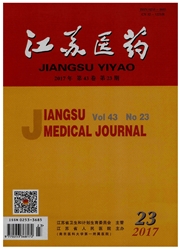

 中文摘要:
中文摘要:
目的探讨胶原诱导性关节炎(CIA)疾病发生发展过程中Th17和Treg细胞来源的儿茶酚胺(CAs)的作用。方法随机将18只雄性DBA/1小鼠分为对照组、CIA模型Ⅰ组(35 d)和CIA模型Ⅱ组(55 d)。Ⅱ型胶原乳剂尾根部注射制备CIA小鼠模型。Real-time PCR法检测淋巴结中Th17细胞的特异性转录因子ROR-γt,相关细胞因子IL-17和IL-22,Treg细胞的特异性转录因子Foxp3,相关细胞因子转化生长因子(TGF)-β以及酪氨酸羟化酶(TH)的m RNA表达。免疫荧光组织化学染色法观察淋巴结中ROR-γt和Foxp3分别与TH、囊泡单胺转运体-2(VMAT-2)和单胺氧化酶(MAO)的共定位情况。结果与对照组相比,CIA模型Ⅰ组和模型Ⅱ组的小鼠淋巴结中ROR-γ、IL-17、TH和IL-22的m RNA表达增加;Foxp3和TGF-β的m RNA表达减少;其中模型Ⅱ组IL-17的m RNA表达与模型Ⅰ组相比有所降低。对照组和CIA模型Ⅰ组及模型Ⅱ组的小鼠淋巴结中存在ROR-γt和Foxp3分别与TH、VMAT-2和MAO的共定位细胞。CIA模型组小鼠淋巴结中ROR-γt/TH、ROR-γt/VMAT-2和ROR-γt/MAO双阳性细胞数增加,模型Ⅱ组中的这些双阳性细胞数与模型Ⅰ组相比有所减少。结论 CIA模型组小鼠淋巴结中Th17细胞合成CAs的能力增强,这种Th17细胞来源的CAs的增加可能在CIA的发生发展过程有一定的抗炎作用。
 英文摘要:
英文摘要:
Objective To explore the role of Th17- and Treg-derived catecholamines during collagen-induced ar-thritis(CIA) progression. Methods Eighteen male DBA/1 mice were randomly divided into control group, CIA model groupⅠ(day 35) and CIA model group Ⅱ(day 55). The CIA models were induced by type Ⅱ collagen(CⅡ) injection from tails.m RNA expression of Th17 specific transcription factor include ROR-γt, cytokines, IL-17 IL-22, Treg specific transcriptionfactor, Foxp3, cytokines, TGF-β and tyrosine hydroxylase(TH) in lymph nodes were examined by real-time PCR. Co-local-ization of ROR-γt or Foxp3, with TH, vesicular monoamine transporter-2(VMAT-2) or monoamine oxidase(MAO) in lymphnodes were observed by immunofluorescence staining. Results In lymph nodes of mice in CIA Ⅰgroup and CIA Ⅱ group,m RNA expression of ROR-γt, IL-17, TH and IL-22 were upregulated, while m RNA expression of Foxp3 and TGF-β ex-pression was downregulated compared to those expression in control group. The upregulated expression of IL-17 was signifi-cantly reduced in CIA Ⅱ group compared with that in CIA Ⅰ group. In the lymph nodes of both intact and CIA mice, co-lo-calization of ROR-γt or Foxp3 with TH, VMAT-2 or MAO was seen in some cells. The numbers of cells that are double-pos-itive of ROR-γt/TH,ROR-γt/VMAT-2 and ROR-γt/MAO IL-17 were increased in CIA groups compared to those in con-trol group. And they are significantly reduced in CIA Ⅱgroup compared with those in CIA Ⅰ group. Conclusion The abili-ty to synthesize catecholamines in Th17 cells was increased in lymph node in mice from CIA groups compared to that in con-trol group. The increased catecholamines production from Th17 cells in lymph nodes may be involved in the anti-inflammato-ry progression in CIA.
 同期刊论文项目
同期刊论文项目
 同项目期刊论文
同项目期刊论文
 期刊信息
期刊信息
